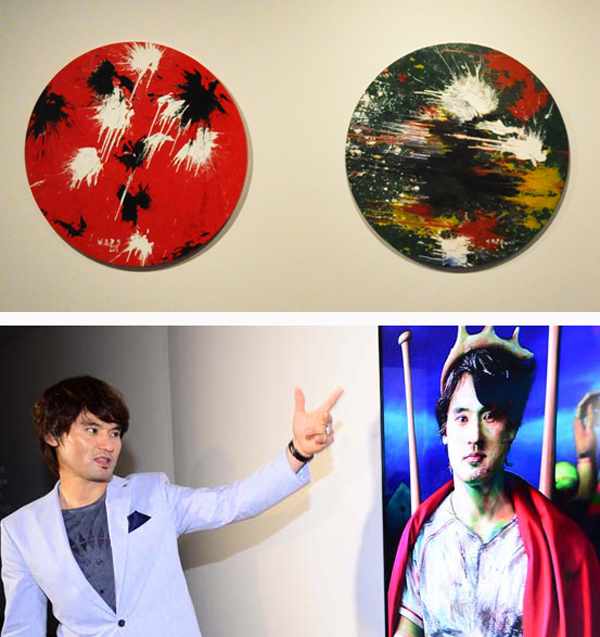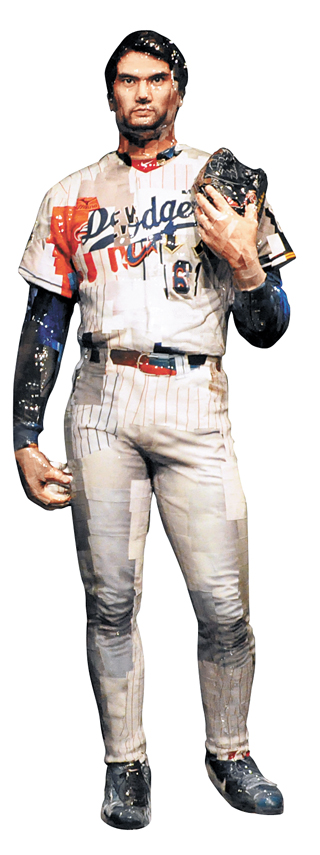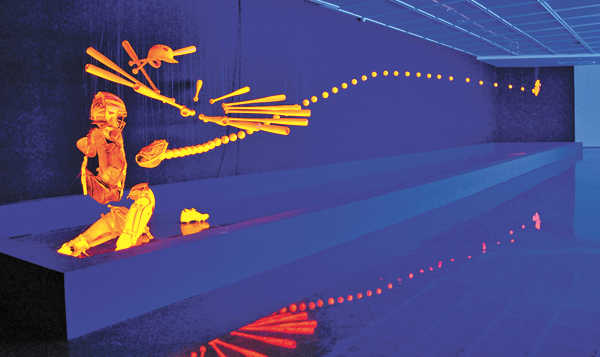Park’s baseball life becomes a work of art

An exhibition themed on Park Chan-ho, “The Hero That Is We,” showcases Park’s artworks, like the paintings he created by pelting baseball onto the canvas, left, as well as works from artists such as Yu Hyeon-mi, who painted a portrait of Park, shown at right. Provided by Seoul Museum
That belated epiphany prompted the former major league star to collaborate with local artists to construe him as both the subject and the object of an artwork. The brainchild is “The Hero That Is We,” the country’s first-of-its-kind art exhibition themed on a sports star.
The exhibition, which kicks off a four-month run tomorrow at Seoul Museum in Buam-dong, central Seoul, reveals more of Park’s soft side after his memoir published last month.
“After retirement, I took an interest in art management and that taught me that people can express their daily routine or life pattern in the form of arts,” the 40-year-old former pitcher, who retired last year, said while giving a tour to a group of reporters on Monday. “I realized that I was also doing an art on the mound. I was trying to create something.”

Other artworks were created by eight artists, including famous cartoonist Lee Hyun-se. Lee, who earned fame with a 1980s hit cartoon about genius baseball pitcher Kkachi, drew cartoons of Park, based on the childhood anecdotes that Park told him, including of jumping off a running train to test his valor like Kkachi. “Everybody wanted to relate to Kkachi as if they are him, and I was one of them,” Park said.
Another artwork was a painting of him by Yu Hyeon-mi. In the painting, Park is wearing a red cape with a wooden crown, but inside the cape was a dirt-stained uniform. The motif came from the story of “The Prince and The Pauper.” Park said that he was a prince on the surface, but felt like a pauper inside.
“She (Yu) asked me how I would like to express myself, and I told her of a sense of inadequacy I felt when people put me in splendid clothes as if I were a hero,” Park said. “Underneath, I was only afraid and nervous. I had agony like a pauper.”
The title of the exhibition reflects his success to overcome his mental pressure. Park said that he learnt to appreciate being called a hero when he realized that everybody can be one.
“I felt pressured and inadequate when people called me a hero. But, slowly I realized that everybody’s life can be appreciated by others. We all can be a hero to somebody else,” he said.
The exhibition will also showcase a wide collection of his baseball items, trophies and photos. It is the first time that the Korean public will get a glimpse of them. As the first Korean major leaguer, Park amassed many records and about 360 items at the exhibition will shed light on his MLB career as one of the most successful Asian baseball players.
Many of his beloved items are on display, including 124 baseballs, one for each of his career victories, the most by an Asian pitcher in the major leagues.
The uniforms and gloves worn by his colleagues, rivals or acquaintances are also exhibited, such as those of Clayton Kershaw and Ichiro Suzuki. He also displays the uniforms of Ryu Hyun-jin, his Hanwha Eagles teammate who is now following in his footsteps with the Los Angeles Dodgers.

Other works on display at the exhibition include Park’s statue, left, and a sculpture describing the trajectory of Park’s curve ball. Provided by Seoul Museum
“He spared extra time teaching me at a minor league stadium where there were no reporters so that we would not be disrupted,” Park recalled, pointing to a photo of him and Koufax on the wall. A blurred message was written on the photo, which Koufax left for Park.
“It was something like, ‘You are now off to a long journey.’ I didn’t understand what it meant at that time, but looking back now, I now know what he tried to say,” Park said.
At the end of the tour with reporters, Park removed a diamond ring from his finger and put it in a glass box for the exhibition. It was the ring that he earned when his Philadelphia Phillies won the National League pennant in 2009. The Phillies advanced to the World Series, where they lost to the New York Yankees.
“It might not be much compared to the two rings that Kim Byung-hyun has,” said Park, referring to his peer, who won two World Series with the Arizona Diamondbacks in 2001 and the Boston Red Sox in 2004. “But, this is a really valuable thing for me. All the lessons that I have learnt in the major league seem to be melted here.”
BY MOON GWANG-LIP [joe@joongang.co.kr]










with the Korea JoongAng Daily
To write comments, please log in to one of the accounts.
Standards Board Policy (0/250자)